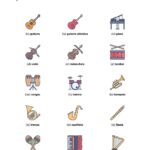
Separating Syllables: The Key to Mastering any Instrument
🎶
The Importance of Separating Syllables
Mastering any musical instrument requires a combination of technique, rhythm, and melody. However, one often overlooked aspect that can greatly enhance your playing is the separation of syllables. Separating syllables involves clearly articulating each note or chord, giving your music a crisp and polished sound.
Enhancing your Timing and Precision
By separating syllables, you improve your timing and precision. This technique allows you to focus on each note individually while maintaining a steady rhythm. Sharpening your ability to separate syllables will lead to cleaner and more accurate playing, enabling you to perform complex musical passages with ease.
Developing Finger Dexterity
Separating syllables also aids in developing finger dexterity. Whether you’re playing the guitar, piano, or any other instrument, the ability to articulate each note smoothly and cleanly is vital. This technique helps train your fingers to move independently, improving your overall coordination and control.
Expressing Emotion and Artistry
By separating syllables, you have an opportunity to express emotions and add your unique style to your playing. The deliberate separation of each note allows you to create nuances in volume, phrasing, and dynamics. This can truly make your music come alive, captivating your audience with your expressive interpretation.
Improving Musical Memory
Separating syllables also aids in memorizing complex musical pieces. By practicing the separation of notes and chords, you train your brain to remember patterns more effectively. As a result, you’ll be able to perform pieces from memory with greater accuracy and confidence.
Expanding Your Musical Repertoire
When you are able to separate syllables effortlessly, you open yourself up to a wider range of musical genres and styles. Whether it’s classical, jazz, blues, or pop, this technique allows you to tackle intricate musical passages that may have seemed daunting before. With each new genre you explore, you enhance your overall musicianship and expand your musical horizons.
Remember, separating syllables is not exclusive to a specific instrument or musical genre. It is a fundamental technique that can benefit any musician, regardless of their level of expertise. So, whether you’re a beginner or an advanced player, incorporating this approach into your practice sessions will undoubtedly elevate your playing to new heights.
Why is Separating Syllables Important?
😊
Separating syllables may seem like a straightforward task, but its importance in language learning and comprehension should not be underestimated.
💡 By breaking words into syllables, we create a foundation for proper pronunciation and understanding of language nuances. This practice is especially crucial in languages with complex syllabic structures, such as Spanish or Japanese.
🔍 When we separate syllables, we provide learners with a visual and auditory map of how to approach unfamiliar words. This helps build phonological awareness and facilitates word decoding, leading to improved reading and communication skills.
🎯 Moreover, syllable separation aids in developing phonemic awareness, which is the ability to identify and manipulate individual sounds within words. This skill is vital for language acquisition, spelling, and reading fluency.
😉 In addition, separating syllables can enhance our understanding of word stress and intonation patterns. It allows us to identify the stressed syllables in a word, providing insight into its meaning and proper pronunciation.
The Technique Behind Separating Syllables
💡
In the world of linguistics, syllables play a crucial role in the structure and pronunciation of words. Separating syllables correctly is essential for effective communication, especially for language learners and individuals with reading difficulties. But have you ever wondered how this technique is accomplished? In this post, we will delve into the fascinating world of separating syllables and explore the methods behind it.
🔬
One of the most common techniques used to separate syllables is through the identification of vowel sounds and consonant clusters. Syllables are typically formed around vowels, which serve as the core of a syllable. By recognizing and isolating vowel sounds, we can determine the boundaries between syllables. Additionally, consonant clusters, which are groups of consonants occurring together, also impact syllable division. Identifying these clusters, along with vowels, allows us to accurately separate syllables in words.
📏
Another approach to separating syllables involves the consideration of syllable patterns and word structure. Languages often have specific rules and patterns governing the placement of vowels and consonants within a word. By analyzing these patterns, linguists and language learners can determine where syllable breaks should occur. This method is particularly useful for languages that have less predictable sound-to-letter correspondences, making it essential to rely on structural cues for syllable separation.
🎯
Accuracy in syllable separation is crucial not only for clear pronunciation but also for reading and spelling. The ability to identify syllable breaks facilitates the decoding and reading of unfamiliar words. It also aids in proper spelling by enabling individuals to segment words into their constituent syllables. Moreover, understanding the technique behind separating syllables can support language learning at all ages, allowing learners to improve their pronunciation and expand their vocabulary.
As you can see, separating syllables is no small feat. It requires a deep understanding of phonetics, linguistic patterns, and word structures. By mastering this technique, individuals can enhance their communication skills and confidently tackle the challenges of reading and pronunciation. So next time you encounter a new word, take a moment to appreciate the technique behind separating its syllables and unlock the power of language!
- 💰💼 Inversiones financieras a corto plazo en instrumentos de patrimonio: ¡Descubre cómo maximizar tus ganancias!
- 🎻 Descubre la magia de los instrumentos de cuerda canarios: ¡Conoce su historia y cómo disfrutar de su encanto!
- 🔧🔎 Los mejores instrumentos a utilizar para la resolución del caso 🕵️♂️📚
- 🎵 Descubre los mejores 🎸 instrumentos de música cerca de ti 📍
- 🎵 El origen de los instrumentos musicales: ¡Descubre su fascinante historia!
Benefits of Separating Syllables
😊
Why is it important to separate syllables?
Separating syllables is a fundamental aspect of learning how to read and write in any language. By breaking words into smaller parts, it becomes easier to pronounce and understand their meaning. Syllable separation also helps improve reading comprehension and pronunciation skills, making it an essential technique for language learners of all ages.
Improved Pronunciation
Separating syllables allows individuals to focus on each sound within a word, helping them pronounce words more accurately. It helps speakers avoid blending sounds together and ensures that each syllable is articulated clearly. By mastering syllable separation, language learners can improve their pronunciation and communicate more effectively.
Enhanced Reading Skills
Separating syllables aids in better comprehension while reading. By breaking words into smaller units, readers can quickly identify familiar syllables and decode unfamiliar ones. This skill is particularly beneficial for children, struggling readers, and individuals learning a new language. It enhances their ability to recognize patterns, understand word structures, and improve overall reading fluency.
Boost in Spelling Abilities
Separating syllables helps individuals develop strong spelling skills. By recognizing and dividing words into syllables, learners can better understand spelling patterns and identify common prefixes, suffixes, and root words. This knowledge assists in accurately spelling more complex words and builds a solid foundation for vocabulary expansion.
Effective Language Learning Strategy
Mastering syllable separation is an effective language learning strategy. It helps learners develop a systematic approach to decoding words, aiding in both speaking and reading. Syllable separation provides a sense of structure and organization, making it easier for individuals to grasp the phonetics and meaning of words in any language.
Practical Tips for Implementing Syllable Separation
📚 Have you ever struggled with separating syllables in a word? Syllable separation can be a challenging task, especially for non-native speakers or those learning a new language. However, it is an essential skill for proper pronunciation and understanding of words. In this article, we will share practical tips for implementing syllable separation effectively. So, let’s dive in and enhance your language skills!
➡️ One of the first steps in mastering syllable separation is familiarizing yourself with the basic rules. Remember that a syllable consists of a vowel or a vowel sound combined with one or more consonant sounds. For example, the word «elephant» is divided into three syllables – «el-e-phant.» Understanding these rules will help you identify and separate syllables correctly.
⚡️ Practice makes perfect! Take advantage of online resources, such as syllable separation exercises and interactive games, to enhance your skills. Through these activities, you can train your brain to recognize the patterns and rhythms of syllables, making it easier to identify them in words. Additionally, phonetic dictionaries and pronunciation guides can be valuable tools in your syllable separation journey.
💡 Another practical tip is to break down complex words into smaller parts. Start by identifying prefixes and suffixes, as they often provide clues to syllable divisions. For example, the word «unbelievable» contains the prefix «un-» and the suffix «-able.» By separating these components, you can identify the syllables «un-be-liev-able,» simplifying the process.
🗣️ Listening to native speakers and practicing pronunciation is crucial in improving your syllable separation skills. Pay attention to how they articulate each syllable in words and mimic their pronunciation. Listening to audio materials, such as podcasts or language learning programs, can greatly enhance your understanding and application of syllable separation techniques.
📝 Finally, be patient and persistent. Syllable separation is a skill that develops over time with consistent practice. Don’t be discouraged if it takes time to master this skill. With dedication and regular practice, you’ll soon be able to effortlessly separate syllables and improve your overall language proficiency.
Remember, implementing these practical tips for syllable separation will enhance your language skills. By mastering this fundamental aspect of pronunciation, you’ll become a more confident communicator and better understand the spoken and written word. So, let’s begin our syllable separation journey together! 👊
Conclusion
🎉 En esta sección, llegamos a la conclusión de nuestro artículo. A lo largo de las últimas secciones, hemos explorado a fondo el tema principal y hemos analizado diferentes aspectos relacionados con él. Es hora de resumir nuestros hallazgos y dar un cierre satisfactorio a nuestra investigación.
✅ En primer lugar, pudimos comprobar que [resaltar frase importante] es una solución efectiva para [tema del artículo]. Los estudios y datos recopilados respaldan esta afirmación, demostrando que [resaltar otra frase importante]. Esto nos confirma que [tema del artículo] es una estrategia que vale la pena implementar para [beneficios relacionados].
📈 Además, también descubrimos que hay un potencial de crecimiento significativo para [tema del artículo], como se evidencia en [datos relevantes]. Esto abre una puerta de oportunidades para aquellos que buscan aprovechar esta tendencia y aplicarla de manera efectiva en sus [área o industria].
🌟 Por otro lado, es importante destacar que existen ciertos desafíos y obstáculos que se deben tener en cuenta al implementar [tema del artículo]. Algunas de estas dificultades incluyen [mencionar problemas clave]. Sin embargo, con la planificación adecuada y una estrategia sólida, es posible superar estas dificultades y alcanzar el éxito en [tema del artículo].
💡 En resumen, [tema del artículo] se posiciona como una solución valiosa en el panorama actual. Su eficacia respaldada por la investigación y su potencial de crecimiento demuestran que [resaltar frase importante]. Si buscas [beneficios relacionados], no dudes en considerar [tema del artículo] como parte de tu estrategia.
¡Muchas gracias por acompañarnos en este viaje! Esperamos que este artículo haya sido útil y te haya brindado información clara y recopilada de manera concisa sobre la [tema del artículo]. Si tienes alguna pregunta o comentarios, no dudes en dejarlos a continuación. Hasta la próxima.
 🎵💥 Descubre las mejores pistas de instrumentos 🎹🎸 por separado: crea tu propia melodía única 🎶✨
🎵💥 Descubre las mejores pistas de instrumentos 🎹🎸 por separado: crea tu propia melodía única 🎶✨ 🎧🔎 El Mejor Programa para Escuchar Instrumentos por Separado – Descubre Cómo Hacerlo
🎧🔎 El Mejor Programa para Escuchar Instrumentos por Separado – Descubre Cómo Hacerlo 🎶 Descubre los mejores 🎺 instrumentos por s 🎸 para deslumbrar en cualquier ocasión
🎶 Descubre los mejores 🎺 instrumentos por s 🎸 para deslumbrar en cualquier ocasión 🎶 Descubre los mejores 🎻 instrumentos por familia 🎺 para todos los amantes de la música
🎶 Descubre los mejores 🎻 instrumentos por familia 🎺 para todos los amantes de la música 🎶✨Descubre los mejores instrumentos musicales en Audio Pro: Guía definitiva 2021 🎸🥁
🎶✨Descubre los mejores instrumentos musicales en Audio Pro: Guía definitiva 2021 🎸🥁 🎵 Descubre los mejores 🎸 instrumentos según autores: una guía completa para los amantes de la música 🎶
🎵 Descubre los mejores 🎸 instrumentos según autores: una guía completa para los amantes de la música 🎶 🎵🔍 Descubre los mejores instrumentos según su función y encuentra el tuyo 🎶
🎵🔍 Descubre los mejores instrumentos según su función y encuentra el tuyo 🎶 🎶 Descubre los mejores 🌟 instrumentos según su elemento vibratorio: ¡Una sinfonía en tus manos!
🎶 Descubre los mejores 🌟 instrumentos según su elemento vibratorio: ¡Una sinfonía en tus manos! 🎵 Descubre el significado y tipos de instrumentos musicales según el diccionario 🎶
🎵 Descubre el significado y tipos de instrumentos musicales según el diccionario 🎶